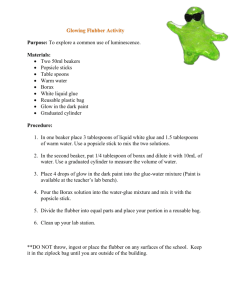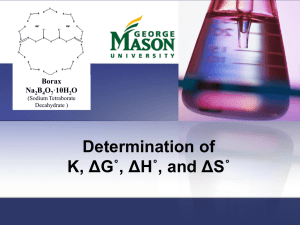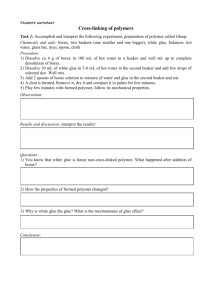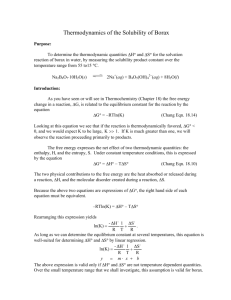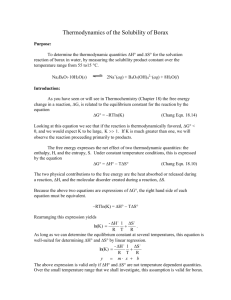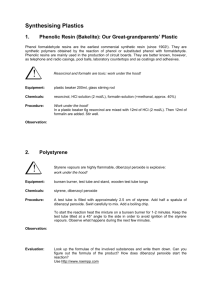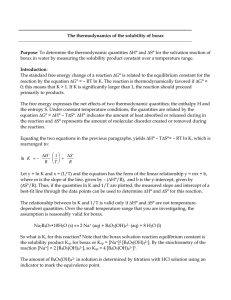Chemistry 163 H° and S° for the solvation
advertisement
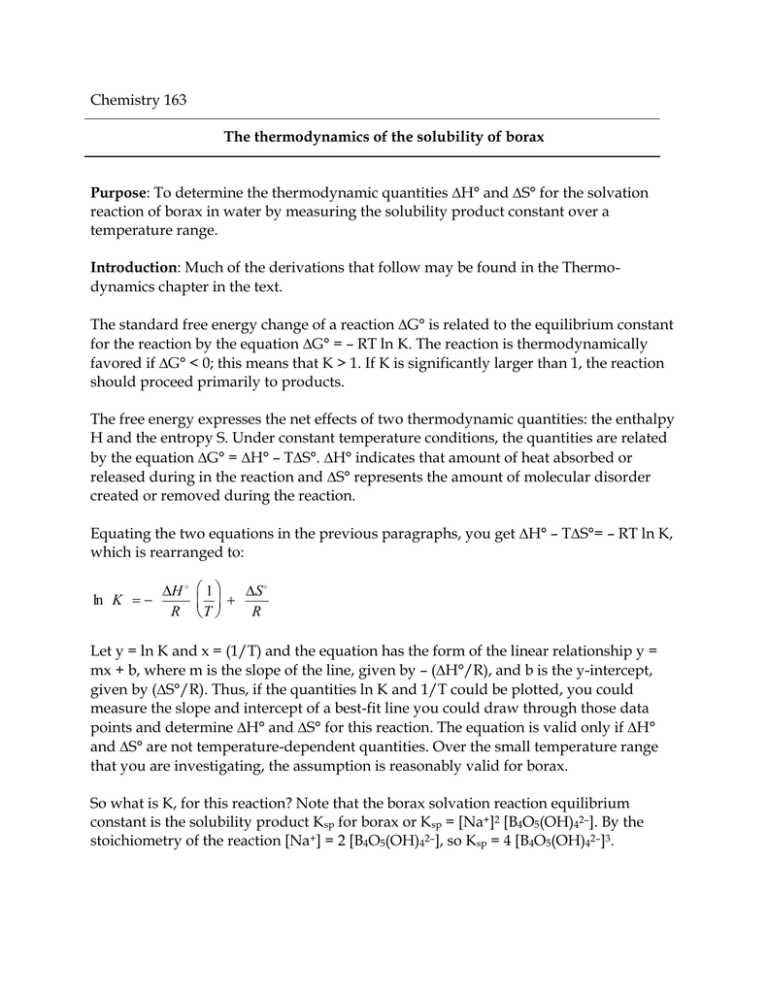
Chemistry 163 The thermodynamics of the solubility of borax Purpose: To determine the thermodynamic quantities H° and S° for the solvation reaction of borax in water by measuring the solubility product constant over a temperature range. Introduction: Much of the derivations that follow may be found in the Thermodynamics chapter in the text. The standard free energy change of a reaction G° is related to the equilibrium constant for the reaction by the equation G° = – RT ln K. The reaction is thermodynamically favored if G° < 0; this means that K > 1. If K is significantly larger than 1, the reaction should proceed primarily to products. The free energy expresses the net effects of two thermodynamic quantities: the enthalpy H and the entropy S. Under constant temperature conditions, the quantities are related by the equation G° = H° – TS°. H° indicates that amount of heat absorbed or released during in the reaction and S° represents the amount of molecular disorder created or removed during the reaction. Equating the two equations in the previous paragraphs, you get H° – TS°= – RT ln K, which is rearranged to: ln K H 1 S R T R Let y = ln K and x = (1/T) and the equation has the form of the linear relationship y = mx + b, where m is the slope of the line, given by – (H°/R), and b is the y-intercept, given by (S°/R). Thus, if the quantities ln K and 1/T could be plotted, you could measure the slope and intercept of a best-fit line you could draw through those data points and determine H° and S° for this reaction. The equation is valid only if H° and S° are not temperature-dependent quantities. Over the small temperature range that you are investigating, the assumption is reasonably valid for borax. So what is K, for this reaction? Note that the borax solvation reaction equilibrium constant is the solubility product Ksp for borax or Ksp = [Na+]2 [B4O5(OH)42–]. By the stoichiometry of the reaction [Na+] = 2 [B4O5(OH)42–], so Ksp = 4 [B4O5(OH)42–]3. Borax or sodium borate is a naturally occurring mineral composed of Sodium, Boron, Oxygen and water. Vast deposits are found in the Southwestern US. The term borax is often used for a number of closely related minerals or chemical compounds that differ in their water content: 1. Anhydrous borax (Na2B4O7) 2. Borax pentahydrate (Na2B4O7 * 5H2O) 3. Borax decahydrate (Na2B4O7 * 10H2O) Borax decahydrate is the form found in most grocery stores and is generally described as Na2B4O7.10H2O. However, it is better formulated as Na2[B4O5(OH)4] * 8H2O, since borax contains the Borate ion, [B4O5(OH)4]2−. In this structure, there are two four-coordinate boron atoms (two BO4 tetrahedra) and two three-coordinate boron atoms (two BO3 triangles). (As shown below.) The amount of B4O5(OH)42– in solution is determined by titration with HCl solution using an indicator to mark the equivalence point. Titration Reaction: 2HCl(aq) + 2Na+(aq) + B4O5(OH)42– (aq)+3H2O(l) 4H3BO3(aq) + 2NaCl(aq) Skills: • Developing a temperature-series set of solubility measurements • Use of an indicator for qualitative determination of the acidity/alkalinity of a solution • Use of a graph to determine a best-fit line • Use of a best-fit line equation to determine thermodynamic quantities Solubility equation: Na2B4O7•10H2O (s) 2 Na+ (aq) + B4O5(OH)42– (aq) + 8 H2O (l) Titration equation: 2HCl(aq) + 2Na+(aq) + B4O5(OH)42– (aq)+3H2O(l) 4H3BO3(aq) + 2NaCl(aq) Chemicals needed: • Borax (make sure it is not “cut” with other cleaning ingredients) • A precisely-known concentration hydrochloric acid solution (~0.2 M) • A concentrated solution of sodium hydroxide (>1 M) • Indicator solutions (phenophthalein) Equipment needed: • five clean 250 mL or larger glassware (beakers, flasks, etc) (Label ‘#1’ – ‘#5’) • one clean 100 mL beaker (‘Beaker A’) • two clean 150 mL beakers (label: ‘Beaker B’, ‘HCl’) • thermometer • buret Prelab: Write your procedure and any needed data tables into your notebook. Procedure: 1. Pick an appropriate indicator: thymol blue (pKin = 1.5), methyl red (pKin = 5.1) or phenolphthalein (pKin = 9.4). The pK of borax is about 4.9. After choosing the indicator, obtain about 10 mL of the HCl solution and add two drops of the indicator to that; stir. Then add drops of concentrated NaOH solution, stirring all the while, until the color change occurs. Note the color change (before and after) in your notebook for future reference. 2. Obtain the five 250 mL glassware, label them #1 through #5. 3. In a 100 mL beaker (Beaker A), prepare a saturated solution of borax by adding roughly 25 g of borax to 50-60 mL of distilled water. Obtain a hot plate and set the heat setting at about midpoint; place the borax solution on the hot plate and stir. You may use the thermometer as a stirring rod, but be gentle. 4. Alongside this beaker, heat another beaker (Beaker B) with about 100 mL of distilled water. 5. Take temperature readings constantly while stirring; make sure the bulb of the thermometer is not touching the sides or bottom of Beaker A. Do not overheat! Heating over 60°C will decompose (not dissolve) the borax. When the temperature of the solution n reaches ~57-58 °C, remove Beaker A from the hot plate. Keep monitoring the temperature of the borax solution. 6. With Beaker A sitting on the countertop, stir the solution until it has cooled to about 55°C. Next, stop stirring, and let the beaker stand with the thermometer in it until the solid has settled to the bottom of the beaker. 7. While the solid is settling out, rinse a 10 mL graduated cylinder with the hot distilled water from Beaker B, which is still heating on the hot plate. (If you pour the hot borax solution into a cold graduated cylinder, the borax will instantly precipitate against the cold glass.) 8. After the solid has finished settling out in Beaker A, read and record the temperature to the nearest 0.1 °C. Immediately, and carefully, decant exactly 5.0 mL of the saturated solution into the warmed 10 mL graduated cylinder. Be careful not to transfer the solid at the bottom of the beaker. Then transfer the contents of the cylinder into glassware #1. Rinse the cylinder with hot distilled water several times and pour these rinses into glassware #1 as well. Note: The solution in glassware #1 (and some of the subsequent glassware samples) will continue to precipitate as they cool throughout the procedure. This is ok! You will redissolve them in step 12, before titrating them with HCl. 9. Next, allow the solution in Beaker A to cool to about 45 °C; make sure you are stirring the solution frequently. When the solution is about 45°C, let the solution stand again (as above) until the solid settles out and follow the sample collection process in step 8 for transferring 5.0 mL of the clear solution, this time to glassware #2. Remember to record the temperature to the nearest 0.1°C. Remember to rinse the graduated cylinder and add the rinses to the beaker. 10. Repeat this procedure near 35°C, 25°C, and 15°C (the last couple of temperatures may require an ice water bath — be careful not to let the beaker tip over in the ice bath), transferring 5.0 mL aliquots to glassware #3, #4, and #5, respectively. 11. Obtain about 100 mL of hydrochloric acid (note its precise concentration in your notebook) in a 150 mL beaker (HCl). Rinse and fill the buret with the acid. 12. Add enough distilled water to glassware #1 through #5 so they each have about 100 mL total (the marking on the glassware is sufficient precision). Add five drops of your chosen indicator to each beaker. Stir the solutions in the beakers to make sure any solid borax is re-dissolved; you may need to warm beakers #1 and #2 to re-dissolve the borax. 13. Titrate each glassware, one at a time, with hydrochloric acid from the buret. For beakers #1 and #2, make sure the buret contains a full 50 mL of hydrochloric acid. Clearly, the amount of acid needed for titration should decrease from beaker #1 to beaker #5. Waste disposal: Place all waste in the “aqueous waste” container in the hood. Data section: 1. Remarks about the choice of indicator, given what titration was to be done 2. Remarks about the indicator’s color change — both endpoint colors as well as any transitional color 3. Mass of borax initially added 4. Table of beaker number, volume of borax solution collected and temperature of collection 5. Observations of how cloudy the collect solution was or how much material crystallized on the inside of the graduated cylinder before the rinses 6. Concentration of hydrochloric acid solution (and units) 7. Table of beaker number and endpoint (equivalence point) volume Postlab: In addition to reporting your data results, conclusions, learning, problems, and errors, complete the following. 1. Determine the concentration of the dissolved B4O5(OH)42– in each sample titrated; show a complete calculation for beaker #1. 2. Calculate Ksp for each borax solution. 3. Prepare a graph of your results, plotting the two quantities x and y (as defined in the introduction). Using either your calculator’s functions or the graphing software functions, determine the equation of the best-fit line through your data points. 4. From the parameters of the best-fit line equation, calculate H° and S° for this reaction. Make sure to keep track of units, especially for R, so that the units of H° and S° work out sensibly. 5. Obtain the rest of the class’s H° and S° values and calculate the mean and standard deviation of each for the class. Determine if there are any outliers, then recalculate the mean and standard deviation, if necessary. Pay attention to units and sig figs. Conclusion and Discussion of Experimental Results The literature values for enthalpy and entropy of the dissolution of borax in water are 110. kJ/mol and 380. J/mol K, respectively. a. Determine the percent error in your experimentally determined values and the class’s mean values. Comment on the confidence you have about this procedure to determine H° and S° for this reaction accurately. b. What are your results and how do they compare to the class results? (The reaction is called borax solvation. c. In comparison to the literature values, how well did the procedure work? Appropriate to add comments about possible error sources, if significant.
